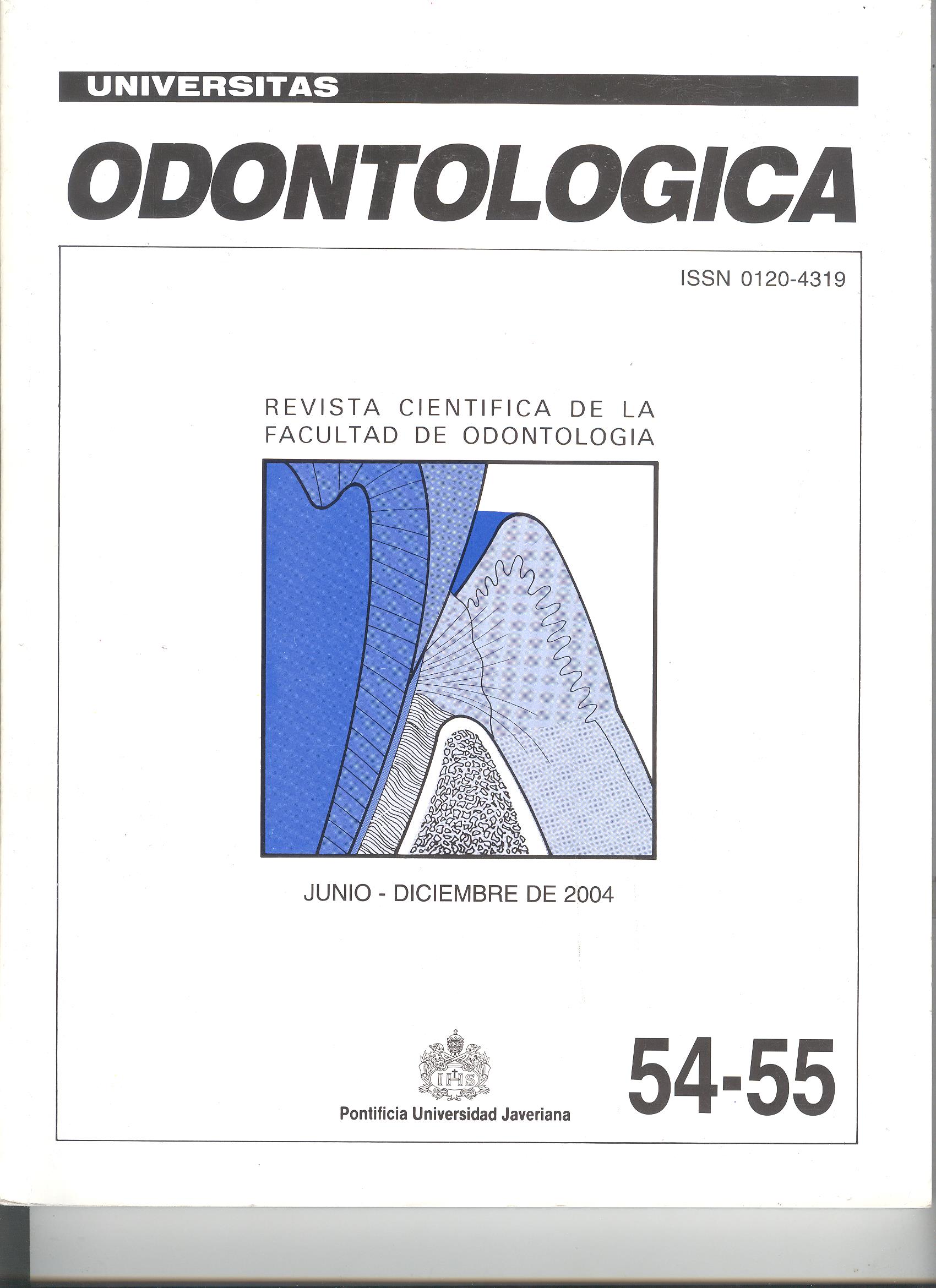Resumen
La caries dental es una enfermedad ampliamente estudiada que se encuentra directamente relacionada con la presencia de Streptococcus mutans, cuyos factores de virulencia más relevantes son la proteína de adhesión (PAc) y las glucosiltransferasas (GTF). Estas últimas son enzimas mediadoras de la producción de glucanos, que permiten la cohesión y maduración de la biopelícula dentobacteriana. Dado el importante papel que estas enzimas tienen actualmente como posible agente de una vacuna contra la enfermedad, este artículo busca revisar los aspectos de mayor relevancia que permitan comprender la estructura y función de estas proteínas.
Bowen W. Vaccine against dental caries - A personal view. J Dent Res 1996; 75(8): 1530-4
Eto A, Saido T, Fukushima K, Tomioka S, Imai S. Inhibitory effect of a self-derived peptide on glucosyltransferase of Streptococcus mutans. J Biol Chem 1997; 274: 15797-802
Giffard P, Jacques NA. Definition of a fundamental repeating unit in Streptococcal glucosyltransferases glucan-binding regions and related sequences. J Dent Res 1994 Jun; 73(6): 1133-41
Jespersgaard C, Hajishengallis G, Greenway T, Smith D, Russell M. Functional and immunogenic characterization of two cloned regions of Streptococcus mutans GTF I. Infect Immun 1999 Feb; 67(2): 810-6
Smith D, Taubman M, Holmberg C, Eascott J, King W. Antigenicity and immunogenicity of a synthetic peptide derived from a glucan-binding domain of mutans streptococcal glucosyltransferase. Infect Immun 1993 Jul; 61(7): 2899-905
Smith DJ. Antibodies to glucosyltransferase induced by synthetic peptides associated with catalytic regions of alfa amylases. Infect Immun 1997 May; 67(5): 2638-42
Taubman M, Holmberg J, Smith D. Immunization of rats with synthetic peptide constructs from the glucan binding or catalytic region of mutans streptococcal glucosyltransferase protects against dental caries. Infect Immun 1995 Aug; 63(8): 3088-93
Tsumori H, Minami T, Kuramitsu H. Identification of essential aminoacids in the Streptococcus mutans glucosyltransferases. J Bacteriol 1997 Jun; 179(11): 3391-6
Venkitaraman A, Vacca–Smith A, Kopec L, Bowen W. Characterization of glucosyltransferase B GTF C, and GTF D in solution and on the surface of hydroxyapatite. J Dent Res 1995 Oct; 74(10): 1695-701
Devulapalle KS, Mooser G. Glucosyltransferase inactivation reduces dental caries. J Dent Res 2001; 80(2): 466-9
Vacca-Smith A, Venkitaraman R, Quivey G, Bowe H. Interaction of GTF with a-amilase and starch on the surface of saliva coated hydroxyapatite. Arch Oral Biol 1996; 41(3): 291-8
Shiroza T, Kuramitsu H. Construction of a model secretion system for oral Streptococci. Infect Immun 1993 Sep; 61(9): 3745-55
Munro C, Michaleck S, Macrina F. Cariogenicity of Streptococcus mutans V403 glucosyltransferase and fructosyltransferase mutants constructed by allelic exchange. Infect Immun 1991 Jul; 59(7): 2316-23
Wexler D, Hudson M, Burne R. Streptococcus mutans fructosyltransferase and glucosyltransferase operon fusion strains in continuous culture. Infect Immun 1993 Apr; 61(4):1259-63
Chia J, Hsu T, Teng T, Chen J, Hahn L, Yang C. Glucosyltransferase gene polymorphism among Streptococcus mutans strains. Infect Immun 1991 May; 59(5): 1656-60
Fukushima K, Ikeda T, Kuramitsu H. Expression of Streptococcus mutans gtf genes in Streptococcus milleri. Infect Immun 1993 Jul; 60(7): 2815-22
Yamashita Y, Bowen H, Kuramitsu H. Molecular analysis of a Streptococcus mutans strain exhibiting polymorphism in the tandem gtf B and gtf C genes. Infect Immun 1992 Apr; 60(4): 1618-24
Yamashita Y, Bowen H, Burne A, Kuramitsu H. Role of Streptococci mutans gtf genes in caries induction in the specific pathogen-free rat model. Infect Immun 1993 Sep; 61(9): 3811-17
Taubman M, Smith D. Effects of local immunization with GTF fractions from Streptococcus mutans on dental caries in rats and hamsters. J Immunol 1977; 118(2): 710-20
Chia J, Lin R, Chen J, Yang C. Inhibition of glucosyltransferase activities of Streptococcus mutans by a monoclonal antibody to a subsequence peptide. Infect Immun 1993 Nov; 61(11): 4689-95
Fukushima K, Okada T, Ochiai K. Production, characterization, and application of monoclonal antibodies which distinguish three glucosyltransferases from Streptococcus mutans. Infect Immun 1993 Jan; 61(1): 1323-28
Chia J. Antigenicity of a synthetic peptide from glucosyltransferases of Streptococcus mutans in humans. Infect Immun 1997; 65(3): 1126-30
Laloi P, Munro C, Jones K, Macrina F Immunologic characteristics of a Streptococcus mutans glucosyltransferase B sucrose-binding site peptide cholera toxin B subunit chimeric protein. Infect Immun 1996 Jan; 64(1):28-36
Alaluusua S, Gronroos L, Zhux, Saarela M, Matto J et al. Production of GTF by clinical mutans streptococcal isolates. Arch Oral Biol 1997; 42(69): 417-4
Mattos RO, smith DJ, king WF, Mayer PA. Waterinsoluble glucan synthesis by mutans streptococcal strains correlates with caries incidence in 12-to-30-month-old children. J Dent Res 2000; 79(6): 1371-77
Kawata S, Torii M, Fujiwara T, Hamada S. Effects of selected surfactants on purified glucosyltransferases from mutans streptococci and cellular adherence to smooth surfaces. J Med Microbiol 1993; 38: 54-60
Vacca-Smith A, Bowen WH. In situ studies of pellicle formation on hydroxyapatite discs. Arch Oral Biol 2000; 45: 277-91

Esta obra está bajo una licencia internacional Creative Commons Atribución 4.0.
Derechos de autor 2004 Universitas Odontologica


